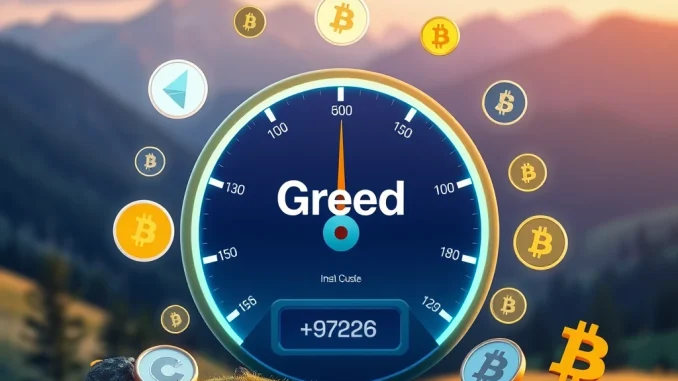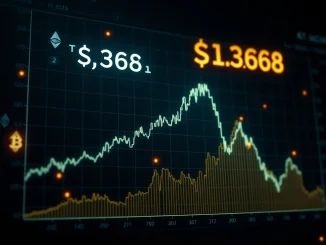
The crypto market is buzzing, and a key indicator is flashing ‘Greed’. The Crypto Fear and Greed Index recently climbed to 73, signaling a notable shift in overall market sentiment. This move upward, just three points from the previous day, keeps the index firmly within the ‘Greed’ territory. For anyone tracking the pulse of the crypto market, understanding this index is crucial.
What Exactly is the Crypto Fear and Greed Index?
The Crypto Fear and Greed Index, provided by Alternative, is a popular tool used by traders and investors to gauge the prevailing emotional state of the cryptocurrency market. It operates on a simple principle: extreme fear can be a sign that investors are too worried, potentially creating a buying opportunity, while extreme greed can mean the market is due for a correction.
The index ranges from 0 to 100:
- 0-24: Extreme Fear – Investors are panicking, prices may be undervalued.
- 25-49: Fear – Hesitation and worry dominate, potential for accumulation.
- 50-74: Greed – Market is optimistic, prices are rising, caution is advised.
- 75-100: Extreme Greed – Euphoria sets in, market may be overheated, high risk of correction.
As of May 14, the index stands at 73, sitting comfortably in the ‘Greed’ zone. This suggests that market participants are feeling optimistic, perhaps even overly confident, about future price movements.
How is Current Crypto Sentiment Measured?
The Crypto Fear and Greed Index isn’t based on a single factor. It aggregates data from six different sources to provide a comprehensive look at market sentiment. Each factor contributes a specific weight to the final score:
Here’s a breakdown of the components:
- Volatility (25%): Measures the current volatility and drawdown compared to average maximum drawdowns of Bitcoin (BTC). High volatility often indicates a fearful market.
- Market Momentum/Volume (25%): Compares the current volume and market momentum to average values over the last 30 and 90 days. High buying volume in a positive market suggests greed.
- Social Media (15%): Analyzes sentiment and engagement around crypto-related hashtags on platforms like Twitter. High positive sentiment and rapid interaction can indicate greed.
- Surveys (15%): Polls users weekly about their market perception (currently paused).
- Bitcoin Dominance (10%): Measures Bitcoin’s share of the total cryptocurrency market capitalization. Rising dominance can indicate fear (people moving to the perceived safety of BTC) or greed (speculation driving BTC).
- Google Trends (10%): Looks at search queries related to Bitcoin and other cryptocurrencies. Rising search interest, especially for terms like “Bitcoin price manipulation,” can signal fear, while terms like “buy crypto” or “Bitcoin bull run” suggest greed.
The current score of 73 is a result of a combination of these factors leaning towards positive market indicators.
Decoding the Current Market Sentiment at 73
A reading of 73 in the Crypto Fear and Greed Index indicates strong market optimism. Investors are likely feeling confident, buying activity is elevated, and there’s a general positive outlook. While this reflects a healthy, upward trending market, being deep in the ‘Greed’ zone also comes with potential risks.
Historically, periods of extreme greed (above 75) have sometimes preceded market pullbacks or corrections. When everyone is optimistic and buying, there are fewer sellers, and the market can become susceptible to sudden drops if sentiment shifts or large players take profits.
A score of 73 suggests the market is not yet in the ‘Extreme Greed’ territory, but it’s close. This calls for caution rather than blind enthusiasm. It’s a time when FOMO (Fear Of Missing Out) can be powerful, potentially leading to impulsive decisions.
The Role of Bitcoin Dominance in the Index
Bitcoin Dominance plays a specific role in the index calculation. While its weighting is lower (10%) compared to volatility or momentum, it offers insight into market structure. Typically, rising Bitcoin dominance can indicate that capital is flowing into Bitcoin, sometimes seen as a safer haven during uncertainty (fear), or conversely, that Bitcoin is leading a bull run and altcoins are lagging (potentially still indicating underlying optimism but focused on BTC).
When Bitcoin dominance falls, it often suggests capital is flowing into altcoins, which is usually associated with higher risk tolerance and thus, a greedier market environment.
Navigating the Current Crypto Market: Using the Index Wisely
The Crypto Fear and Greed Index is a valuable tool, but it should not be the only factor guiding investment decisions in the crypto market. Here are some actionable insights:
- Use it as a Sentiment Check: Understand the prevailing mood, but don’t trade solely based on the index score.
- Be Cautious in Greed: A high score (like 73) is a signal to be careful. Avoid making impulsive buys driven by FOMO. Consider taking profits or setting stricter stop-losses.
- Look for Divergences: Does the index align with other technical or fundamental analysis? If the index shows extreme greed but on-chain metrics suggest otherwise, investigate further.
- Combine with Other Tools: Use the index alongside price charts, volume analysis, news, and fundamental research into specific projects.
- Understand its Limitations: The index is a sentiment indicator, not a crystal ball. It doesn’t predict future price movements with certainty.
A score of 73 means the market is currently feeling good, but it’s also a reminder that sentiment can change quickly. Staying informed and disciplined is key.
In conclusion, the rise of the Crypto Fear and Greed Index to 73 confirms the current optimistic mood prevalent in the crypto market. While ‘Greed’ can be exciting during price rallies, it’s also the phase where risk increases. By understanding how the index works and using it as one part of a broader analysis strategy, investors can navigate these potentially volatile periods with greater awareness and make more informed decisions.



